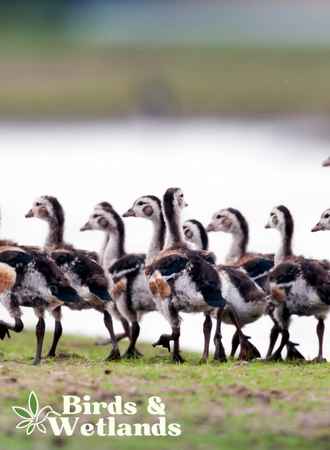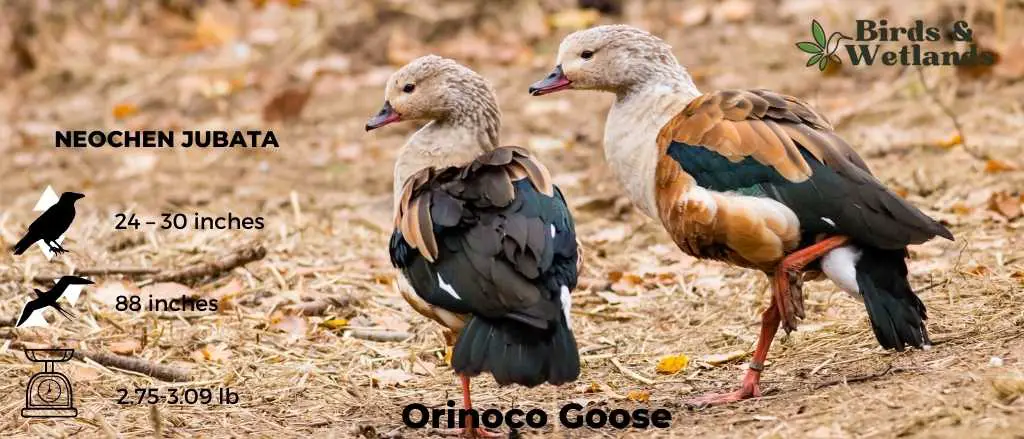The Orinoco goose is widely distributed in Venezuela, Colombia, Brazil, Argentina and Amazon Basin. This species can be found in various habitats, including riverbanks, wetland margins, and open plains.
The Orinoco goose is the only living member of the Neochen genus, a shelduck subfamily. It is named after the most important waterway in northern South America, the Orinoco River.
Scientific Name: Neochen jubata
Length: 24 – 30 inches
Wingspan: 88 inches
Weight: 1250-1400 g
Description
The Orinoco geese are a uniquely beautiful species, with a pale creamy-buff head, neck, and center of the breast. Behind the chestnut flanks is a dark brown crescent which is set off by their blackish wings, which are edged with blackish feathers that extend back to the upper mantle and scapulars, which have a rufous hue. Their bills have a black maxilla and mostly red mandible. Their bright salmon-red legs and feet complete this striking bird’s distinctive appearance.
Males and females look the same but the females are slightly smaller than the males.

Listen to Orinoco Goose
The male makes a high-pitched whistling call while the female cackles.
Habitat
The Orinoco geese inhabit rainforest rivers, wet savannas, sandy shores, freshwater wetlands, sandy beaches and other large wetlands.

Range
The Orinoco goose is a species of waterfowl native to the northern and central regions of South America. Its range extends east from the Brazilian coastline to include Venezuela, Colombia, Ecuador, Peru, Bolivia, and Argentina.
In addition, this species occupies a broad swath across central Brazil from north to south. Due to its wide distribution and relative abundance in many areas, the Orinoco goose has become an important symbol for conservation efforts throughout South America.

Diet
The Orinoco goose feeds primarily on various aquatic plants and terrestrial grasses. This species is well-adapted to river habitats, with long toes that help it forage on the muddy bottom for plant material like sedges and grasses. Additionally, the goose has strong, sharp bills that easily tear apart tough leafy materials. The Orinoco goose will occasionally eat small worms, insects, crustaceans, and mollusks to obtain extra protein.

Nesting & Mating
The Orinoco Goose is a highly adaptable species known for its unique breeding and nesting habits. During the dry season, usually from December to January, they typically hold mating and nesting activities in Colombia and Venezuela. The males are known for their courtship displays which include ruffled feathers and wing lifting.
These birds live in family groups. Unlike many other waterfowl species, these geese prefer to nest at higher elevations, typically choosing a location around 3 meters off the ground in hollow trees or other preferred cavities such as those formed by natural causes like limb loss and rot.
The nests are also typically lined with whitish down for added insulation and may be rotated throughout the breeding season according to the bird’s needs due to changing weather conditions.
Additionally, where available, Orinoco geese have been found to take advantage of readily-available nest boxes for additional nesting materials.
The female Orinoco typically lay 6-10 pale brownish to creamy eggs in a single clutch, and they incubate these eggs for anywhere from 28-30 days to 32-34 days. During this period, the male goose remains in the vicinity of the nest, watching over and protecting the eggs from potential predators or intruders.
Once the chicks have hatched, the goslings are small, black feathered bundles with white markings on their upper parts and stark white underparts.
Additional distinguishing characteristics include a black spot on the ear coverts, narrow dark bands on the sides and hind neck, and broad white bands on the wings and back.
As the young geese grow and develop, both parents take on a role in caring for them and ensuring their safety. The male goose is an especially fierce protector of his family and territory, responding aggressively to any potential threats by charging toward them to scare them off.

Population & Conservation
The Orinoco goose has recently experienced a dramatic population decline despite its large range due to heavy hunting pressure and the loss of suitable habitat.
Nevertheless, this species can still be found in some protected areas, and the global population has been estimated to be around 10,000-25,000 mature individuals.
Currently, the Orinoco goose is classified as Near Threatened on the IUCN Red List of Threatened Species, indicating that it continues to face serious threats to its survival in the coming years.

Key Points
Orinoco geese are omnivores that primarily feed on plant materials such as aquatic algae in stagnant water.
Males make a “high whistle” sound while the females make a “loud cackle”.
The Orinoco goose is currently considered a Near Threatened species.


